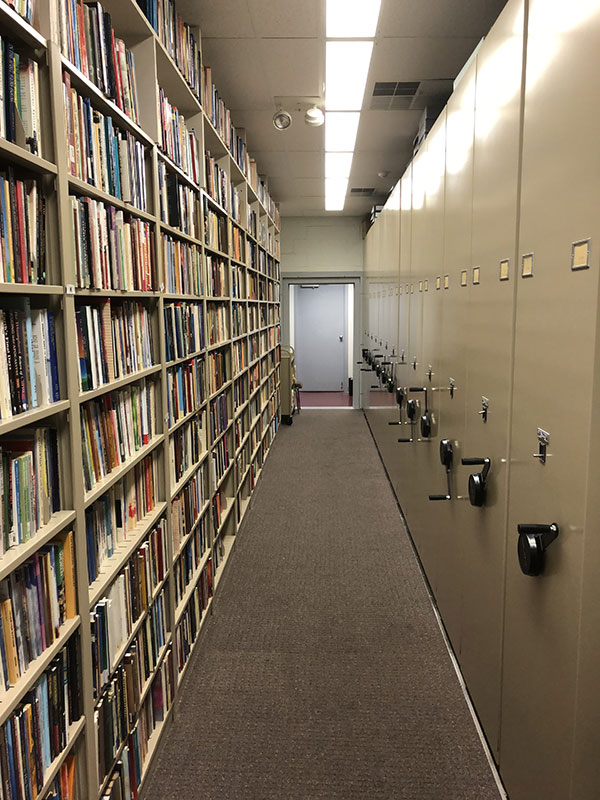 Flower Pentecostal Heritage Center
Flower Pentecostal Heritage Center
FPHC History
Fortieth Anniversary of the Flower Pentecostal Heritage Center
By Wayne E. Warner and Darrin J. Rodgers
Originally published in Assemblies of God Heritage, 37/38 (2017/2018): 42-49.
The Flower Pentecostal Heritage Center (FPHC) plays a unique role in the Assemblies of God (AG) and the broader Pentecostal movement. Over the past forty years, the FPHC has developed into the largest Pentecostal archives in the world. Located in the Assemblies of God national office in Springfield, Missouri, the FPHC has become an important hub for Pentecostal history and research, preserving and promoting Pentecostal testimonies and identity so that future generations can know the works of God.
The Flower Pentecostal Heritage Center originated as a vision in the late 1960s in the mind of a young Assemblies of God scholar, William W. Menzies, who was writing his dissertation on the history of the Assemblies of God. Many first-generation Pentecostals were still alive, yet materials documenting Pentecostal history were difficult to find. Menzies realized that the heritage and testimony of Pentecostals would be lost, unless intentional steps were taken to create an archives.
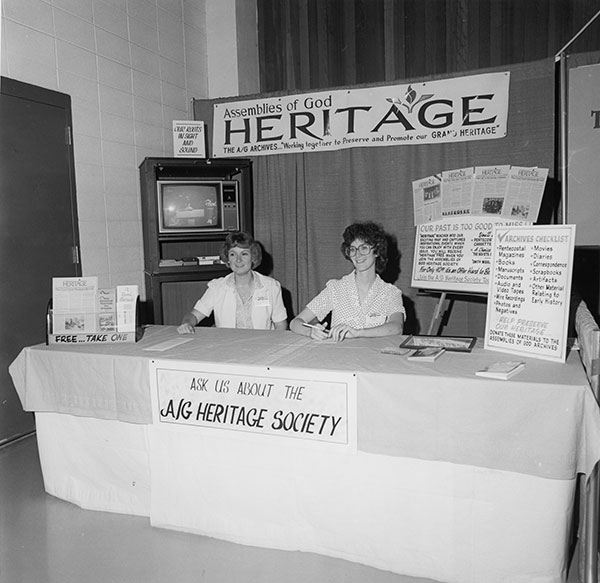
Staff members Pamela Eastlake (left) and Jodie Loutzenhiser (right) at the Conference on the Holy Spirit in 1982.
Finally, in 1977, after years of discussion in committees, the Assemblies of God Archives was established. From small beginnings, great things developed. Assemblies of God Heritage magazine was founded in 1981, the name of the archives was changed to Flower Pentecostal Heritage Center in 1997, its museum opened in 1999, and its online research center went live in 2000.
Today, the work of the Flower Pentecostal Heritage Center is more necessary than ever. With each passing year, Pentecostals become further removed from the important themes, people, and revivals that shaped the movement. The FPHC preserves and promotes these voices from history, which hopefully will inspire new generations to embrace the Pentecostal testimony as their own.
Vision for an Archives
Planning for an Assemblies of God archives began in earnest during the early 1970s. Those involved in the initial discussions probably could not foresee the expansive Center that exists today. But it was a beginning. Much of the credit can be given to the late William W. Menzies, who served at the time as a professor at Central Bible College.
In 1968, when the Assemblies of God was six years away from its sixtieth anniversary, the Executive Presbytery commissioned Menzies to write a new denominational history. The executives knew Menzies and respected the fact that he had grown up in a pastor’s home, was a graduate of Central Bible College and Wheaton College, and had just completed a doctorate in History at the University of Iowa.[1] Menzies’ new book, Anointed to Serve,[2] was introduced at the 1971 General Council in Kansas City. For many years colleges used it as the standard history of the AG.
The need for an archives surfaced during Menzies’ research. He experienced difficulty sorting through various file cabinets in the Pentecostal Evangel office, the Office of Information, and Central Bible College. He was being more than charitable when he wrote that he had spent two months in the Assemblies of God “Archives”—ten years before there was an official archives.[3]
While archival resources were lacking, Menzies was able to interview first- and second-generation pioneers such as J. Roswell Flower, Ralph Riggs, E. S. Williams, Noel Perkin, Gayle Lewis, James Hamill, Bert Webb, Frank Boyd, Aaron A. Wilson, and others. Menzies wrote that their “vantage point scans the Pentecostal Movement from its beginnings.”[4]
Menzies’ difficulty finding historical materials prompted him to push for the establishment of an official archives—not only for the preservation of important documents, but also to provide access to future researchers.
It was another three years, January 1974, before the Archives Study Committee was formed to study the need and make a report. General Superintendent Thomas F. Zimmerman appointed National Director of Publications Lee Shultz to serve as chairman. Two other committee members appointed were General Secretary Bartlett Peterson and Menzies. Assemblies of God Research Secretary Grace Carroll was named as a resource person.[5]

Dr. William W. Menzies, 1977.
Menzies visited or contacted 13 other church groups, seeking information about their archives and how they were organized. When the committee presented its report to the Board of Administration in March 1974, it opened with an arresting statement: “With each passing year of time it becomes more apparent that we must preserve the story of the Pentecostal revival out of which the Assemblies of God movement was born.”[6] The committee’s next report cited the importance of acting as soon as possible: “We are at a point in time when certain information and materials are still available. There is however, an urgency in obtaining materials before they slip away from us.”[7]
The Board of Administration accepted the report and recommended it to the Executive Presbytery, June 12, 1975, which gave the proposal a green light to establish the Assemblies of God Archives for the then 61-year-old denomination.[8]
The archives was not to become a collection of miscellaneous old things locked in a damp cellar, but it was to become an active facility as evidenced by the mission: “1) Insuring that records of the Assemblies of God having enduring value are collected and preserved. 2) Providing historical documentation for evaluation of the continuity of purpose of the Assemblies of God. 3) Making archival records accessible to the public for historical research, analysis, and other approved uses.”[9]
Debut of the Assemblies of God Archives
Finally, in 1977, the Assemblies of God Archives opened its doors. The archives initially was placed under the administration of the Assemblies of God Graduate School (AGGS), which had opened just four years earlier and was located on the fifth and sixth floors of the Gospel Publishing House Distribution Center.
It seemed logical to join the archives with the new school. Having a research facility would help AGGS in its application for accreditation, and students would benefit by having easy access to the archives. Ownership of the materials in the archives, however, would remain with the denomination.[10]
The Assemblies of God Archives was located adjacent to the AGGS library on the fifth floor. The archives would remain in this location until 1997. Harris Jansen, as director of Research Services for AGGS, had oversight of the Cordas C. Burnett Library and the archives.[11]
Pam Eastlake, who was reared in nearby Central Assembly and had training and experience in the archival field, was hired as archives assistant (title later changed to archivist). Emily Johns served as a part-time secretary, a position she held until she and her husband Greg began preparations for World Missions service in South Africa.
An Archives Advisory Committee (later Advisory Board) was created and included Harris Jansen, director; Pam Eastlake, archives assistant; Delmer Guynes, AGGS executive vice president; J. Calvin Holsinger, Evangel College professor; Gerard Flokstra, Central Bible College librarian; Verna Flower, headquarters research secretary; and Juleen Turnage, director of the Office of Information (later called Office of Public Relations).
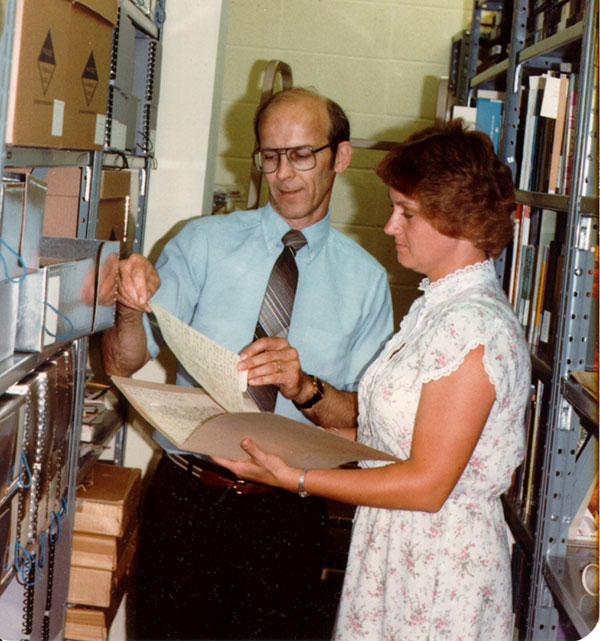
Wayne Warner and Pamela Eastlake looking at materials in the archives vault, 1982.
New space for the archives, including a small walk-in vault, was constructed in early 1978. A policy manual to steer the new ship on its course was also created. Minutes of the May 9, 1978 Archives Study Committee revealed a broadening vision for the archives. Assemblies of God materials would always be the core collection, but the committee then made up of of Guynes, Jansen, Eastlake, and Holsinger began thinking beyond the denomination and encouraged collecting materials from the broader Pentecostal field.[12] They were thinking outside the box and helped lay the foundation for what would become the largest Pentecostal archives in the world.
The school administration kept a close watch over the archives, ensuring that expenses remained under its annual $35,000 budget.[13]
Eastlake was assigned the major task of surveying and gathering documents from the Headquarters departments and organizing nearly 65 years of the Assemblies of God story. With her archival training and denominational background, she became the key person who developed the methods of organizing materials that would guide future archives employees and researchers.
The 1980s: Significant Expansion
When Jansen transferred from the archives to direct AGGS extension education in 1979, Eastlake assumed responsibilities of the day-to-day operations of the archives until the summer of 1980, when the Headquarters Board of Administration invited Wayne Warner to become the first full-time director. Warner left his book editing job at Gospel Publishing House and moved from the fourth floor to the director’s office on the fifth floor. At the time, Warner and Eastlake were the only two staff members of the archives.
The year 1981 proved eventful for the archives, which included an administration change. The Board of Administration moved the archives from AGGS to the oversight of the denomination’s General Secretary, Joseph Flower. The archives remained on the fifth floor—but began answering to the general secretary. This change facilitated a closer working relationship between the archives and the various departments within the denomination. Among the positive changes were better funding, newer technology, and more generous travel and personnel budgets.

Dr. Edith Blumhofer in the archives, circa 1985.
The archives quickly became a destination for the small but growing number of Pentecostal historians. Edith Blumhofer, Gary McGee, Stanley Burgess, Grant Wacker, and Vinson Synan were among the earliest Pentecostal scholars to spend time in the archives. Since then, countless students, church leaders, and researchers have utilized the resources of the FPHC.
Joseph Flower was a major contributor to the success of the archives. As general secretary, he served in the same role as his father, J. Roswell Flower. Having witnessed the early Pentecostal revivals and the development of the Assemblies of God, he had a deep sense of the importance of preserving historical materials for future generations. He realized that history and identity are intertwined. Flower championed the cause of history, raising money and the stature of the archives. In 1997, four years after Flower’s 1993 retirement, the archives was renamed Flower Pentecostal Heritage Center, in honor of the Flower family. After the museum was dedicated in 1999, he loved to walk through the exhibits, view the videos, and reminisce about many pioneers he knew as a child and in his early ministry.

Early copies of Assemblies of God Heritage magazine.
A second important event for the archives happened in 1981. At the General Council held in St. Louis, General Superintendent Thomas F. Zimmerman introduced attendees to the new quarterly Assemblies of God Heritage. It was only a four-page duotone periodical, but it caught on. The number of pages gradually increased, and color was added in 1999. Former country singer and evangelist T. Texas Tyler graced the first all-color cover. More than one reader said they put everything else aside when Heritage arrived in their mailboxes.
Wayne Warner also launched an oral history project in 1981. He realized that most people will not write their memoirs but, if given a chance, they will consent to sit down to record an interview. Warner drew inspiration from AGGS professor Del Tarr, who recorded video interviews of Pentecostal pioneers as part of his communications class. Warner sat down with numerous pioneers and recorded over 700 hours of oral history interviews. Interviewees included Alice Reynolds Flower, Bert Webb, Ralph Harris, Frank Boyd, Irene Pearlman, Josephine Williams, Everett Phillips, Harriet Schoonmaker Bryant, and numerous others. Most of these people are now with the Lord. These priceless interviews are preserved in the archives vault and are available on DVD.
Most of Warner’s interviews were audio rather than video, and many were conducted on the road. Warner interviewed men and women in nursing homes, auditoriums, apartments, churches, hotels, in a Missouri home with 75 chiming clocks, and once while sitting on the front porch of a Charleston, West Virginia, house while the interviewee’s construction crew was building a house next door.
Early in his career at the archives, Warner added two staff archivists who proved to be faithful, invaluable members of the team. Joyce Lee began work at the archives in 1986, and Glenn Gohr began in 1987. Both were previously on staff at the Assemblies of God Theological Seminary (AGTS, formerly Assemblies of God Graduate School) library. Lee and Gohr became standard fixtures at the archives, developing in-depth knowledge of the archives and of AG history. Today, over 30 years later, they continue to work at the FPHC.
The 1990s: Modernizing the Archives
An important period of progress at the FPHC came when George O. Wood was elected as General Secretary in 1993. Dr. Wood, the son of missionaries, loves Pentecostal history and brought new ideas for moving the Center to a more adequate location, raising funds for the new facility, and replacing microfilming with digitization. The FPHC owes much to Dr. Wood for his active leadership to modernize the archives.
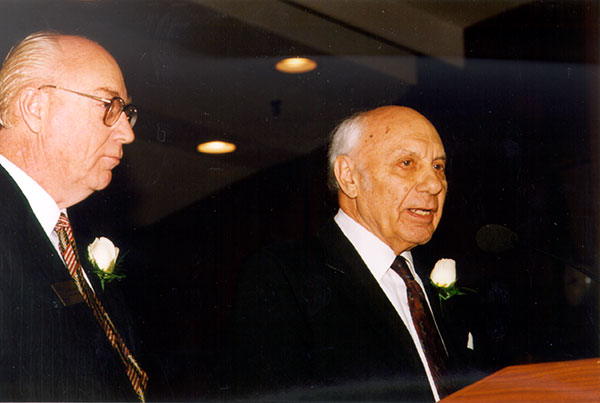
Dr. George O. Wood and Joseph Flower at the dedication of the FPHC in 1999.
One of the first new projects taken on by archives staff under Wood’s oversight was production of the biennial In Memoriam booklet, which includes the names and photos of Assemblies of God ministers who died during the previous two years. The booklets, which are distributed to surviving family members and at General Council meetings, honor those who devoted their lives to building the Church through the Assemblies of God. The FPHC took over publication of the booklets in 1995. In prior editions, the booklets included names without photos. It is a large task—FPHC staff members contact surviving relatives of the approximately 800 deceased ministers each biennium in an effort to obtain photographs and other historical materials.[14]
The most visible sign of change and progress for the archives came in the late 1990s. AGTS moved in 1997 to its new building on the Evangel University campus, which left the archives alone on the fifth floor of the Distribution Center. Because World Missions was going to take over the entire fifth and sixth floors, the archives would have to move.
With executive approval, the archives began looking for a new location. Suggestions included moving into the former headquarters and printing building at 434 West Pacific Street, about three blocks away. It seemed like a great concept, as figures like E.N. Bell, John Welch, Stanley Frodsham, and J. Roswell Flower had labored in that historic building. But the building was dilapidated and disconnected from the headquarters complex.
Other property was available but nothing seemed to fit the special needs of an archives. In the meantime, approval was given to build in the GPH printing area an 800-square-foot climate-controlled vault with compact moveable shelves. The vault was large and beautiful compared to the small, overflowing vault in the previous location.
However, suitable space for the archives office and research room could not be located, to the disappointment of archives staff. The archives moved to temporary space on the second floor of the administration building. During this time, Brett Pavia was hired to fill a new position, Coordinator of Special Projects. Pavia was responsible for a massive digital scanning project, the launch of a new website in 2000, designing each issue of Heritage, and other computer-related assignments.
A new day dawned when Assistant General Superintendent Charles Crabtree surprised the archives committee with exciting news—the archives was going to be relocated to a 5,000-square-foot area being vacated by World Missions on the second floor of the administration building, near the main entrance.
Archives staff began brainstorming and doing research about how they could utilize the space. They settled upon a plan to create offices, a research room, an audiovisual room, and an interactive 3,000-square-foot visitors center including a store-front chapel.
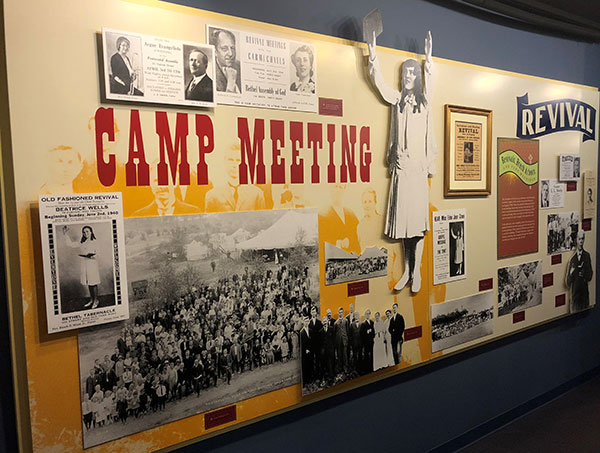
The archives hired a company that specialized in building museum exhibits, Lynch Industries, to help develop and construct the museum. Lynch’s credits included exhibits at the Billy Graham Center (Wheaton, Illinois) and the New York Stock Exchange.
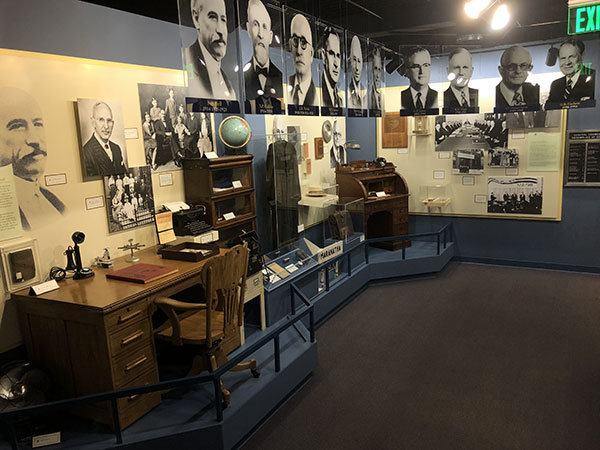
After two years of making plans with Lynch, raising money, and working with a local architect and construction workers, Lynch shipped the exhibits to Springfield in two semi-trailers. The beautiful Flower Pentecostal Heritage Center—with its offices, research room, vault, and interactive museum—was dedicated on January 19, 1999. The Center’s new name—honoring J. Roswell and his family—had been adopted two years earlier when the fundraising campaign was launched. Flower family members participated in the dedication, which was followed by an open house and banquet. After years of delays and hard work, the dream of a world-class Pentecostal archives, research center, and museum finally became reality.
The 2000s: New Leadership, Growth, and Building Bridges
After serving at the helm of the archives for 25 years, Wayne Warner retired in August 2005. Assemblies of God leaders selected Darrin Rodgers, a law-trained Pentecostal historian and archivist, to serve as the third director of the Heritage Center. Rodgers was already well-known in the archives office. Ten years earlier, while a student at AGTS, he had spent hundreds of hours doing research at the FPHC for his book, Northern Harvest: Pentecostalism in North Dakota.[15]
Rodgers brought with him a passion for collecting Pentecostal treasures from across the various denominational, racial, national, and linguistic divides. Rodgers led the FPHC to augment its very strong collections relating to the Assemblies of God USA and early North American Pentecostalism by intentionally seeking materials that document various groups that are under-represented in the history books. Rodgers has a passion for building bridges that has led him to develop relationships with Hispanics, African-Americans, and Native Americans, among others, within the Assemblies of God and other Pentecostal fellowships, which has resulted in the donation of numerous collections at the FPHC.
Some treasure-hunting expeditions proved to be humorous. Rodgers visited Jellico, Tennessee, where he met with Jerome Walden, the retired General Overseer of the Church of God Mountain Assembly (CGMA), a small historic Pentecostal fellowship with churches located primarily in Appalachia. Walden offered to place his collection of historic CGMA publications at the FPHC, but only if Rodgers first preached an impromptu sermon, right there in Walden’s office. He did, and now the FPHC has a significant CGMA collection.
One of the most interesting and enduring relationships has been with Mother Mary P. Patterson, widow of J. O. Patterson, Sr., who served as presiding bishop of the Church of God in Christ (COGIC) from 1968 to 1989. Patterson wanted to place her husband’s personal papers in a professional archives that specialized in Pentecostal history, so she reached out to Rodgers in 2007.
Patterson visited Springfield and was impressed by the FPHC’s facilities and staff. She particularly loved that nearly everyone she met at the AG national office took time to pray with her. She deposited the Bishop J. O. Patterson, Sr. Collection at the FPHC in 2010, and about 1,000 people came to the events surrounding the collection dedication, held at AGTS, Central Bible College, and the AG national office.[16] Patterson and the FPHC have collaborated on various COGIC historical projects, including two symposia and the 2015 dedication of a historical marker at the site of the COGIC’s founding in Lexington, Mississippi.
Patterson was excited about the broader implications of the archival relationship, stating that she wanted to send a signal that the AG and COGIC should develop a closer relationship.[17] And that is exactly what happened. Two COGIC leaders who spoke at the collection dedication—Bishop Lemuel Thuston and Dr. David Daniels—visited with AG general superintendent George O. Wood. As a result of that meeting, Wood developed a relationship with COGIC Presiding Bishop Charles E. Blake, they spoke at the other’s national events, and they brought AG and COGIC leaders together to fellowship and minister on various occasions.
The FPHC did not become the largest Pentecostal archives in the world overnight. Over the years, people have given the FPHC individual items (such as books, tracts, diaries, or photographs), while others have deposited collections both small and large.
The list of people whose personal papers now reside at the FPHC reads like a Who’s Who of the Pentecostal world. The list includes AG church leaders Thomas F. Zimmerman and G. Raymond Carlson; educators Grant Wacker, William W. Menzies, Gary McGee, and J. Robert Ashcroft; Foursquare leader Jack Hayford; and Fellowship of Christian Assemblies historian Henry Jauhiainen. Various important African-American Pentecostal collections, representing the Church of God in Christ and various Oneness churches, have also been deposited at the FPHC. Trinity Broadcasting Network placed its sizeable “C. M. Ward Library” at the FPHC. The archives of several schools—Central Bible College, Bethany University, and Patten University—have also been deposited at the FPHC.
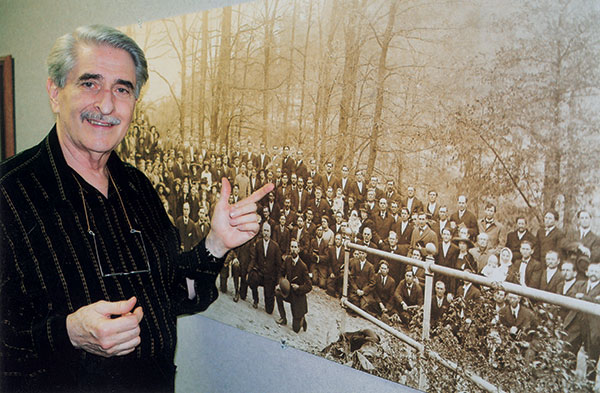
Paul Crouch in the FPHC office, 2003. He is pointing to his father, Andrew Crouch, in group photograph of the first General Council in 1914.
Since 2005, the FPHC’s collection has grown significantly. The number of catalog records in the FPHC’s online catalog has grown from 50,000 to over 120,000, including materials in over 140 languages. In recent years, over ten percent of new acquisitions have been in non-English languages, including many materials documenting the work of various national churches in the World Assemblies of God Fellowship. In February 2018, the top ten non-English languages in the FPHC holdings were: Spanish (1,927); Swedish (653); French (581); German (489); Finnish (264); Portuguese (181); Russian (172); Korean (143); Chinese (128); and Norwegian (122).
Collecting materials telling the stories of Pentecostals from across the world is essential if church leaders and scholars are to better understand the big picture of what God has been doing through the Pentecostal movement. The Assemblies of God and the broader Pentecostal movement have been growing most rapidly in the United States among immigrants and non-Anglos; worldwide, the greatest growth has been outside the Western world.[18]
Continuing to Preserve and Promote the Pentecostal Testimony
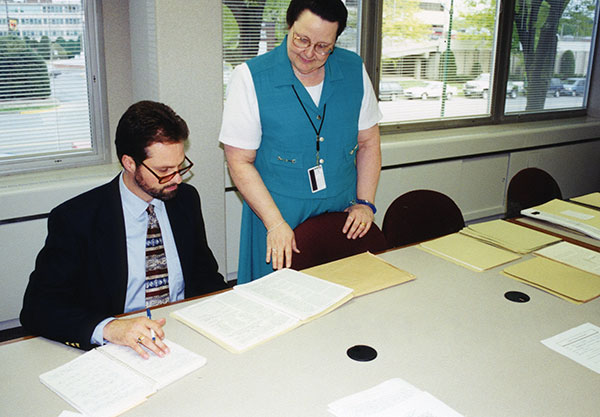
Researcher Thomas Fudge in the FPHC research room with archivist Joyce Lee, 1999.
Much of the success of the FPHC is due to the behind-the-scenes work of dedicated archivists who have subject-matter expertise and technical cataloging and archiving skills. Joyce Lee, who served as Archivist from 1986 until her retirement in 2013, oversaw the cataloging of all materials. She continues to work part-time. Her successor, Bob Sears, brings to the FPHC several decades of experience as a library director and a longtime passion for Pentecostal history.
Glenn Gohr started at the FPHC in 1987 as an Archival Assistant and now is Reference Archivist. He also oversees the photograph and audio-visual collections and is copy editor of Heritage magazine. He is the resident expert on Springfield Pentecostal history and—quite literally—knows where the bodies are buried. He is known for his tours of local cemeteries.
William Molenaar succeeded Brett Pavia in 2007 and served as Digital Archivist until 2015. He oversaw the digitization of about 400,000 pages of Pentecostal periodicals and the continuing development of the website. Sharon Rasnake served as a very capable office administrator from 2001 until her retirement in 2012. Others who served for shorter periods of time also contributed greatly to the success of the FPHC.
The FPHC preserves its extensive collection of Pentecostal treasures in two primary locations. Items that are most important or frequently-accessed are stored in its 800-square-foot climate-controlled vault in the AG national office. The FPHC also stores materials in a 4,500-square-foot secure cave in the Springfield Underground—a sprawling system of secure warehouses built in old mining tunnels left by a limestone mining operation. The cave is an ideal location for preservation of materials—it has constant temperature and humidity and is tornado-proof.
These Pentecostal treasures are made accessible to researchers in several ways. For those who want to do in-depth historical research, nothing beats a visit to the FPHC. Those unable to visit Springfield may purchase photocopies of materials for a nominal fee through the FPHC’s reference services. The FPHC staff has assisted countless scholars, students, church leaders, and people in the pew.
Another important way that the FPHC makes its materials accessible is through its website (www.iFPHC.org), which was redeveloped in 2007. The website has become an indispensable tool for researchers, featuring its online catalog, as well as free access to over 350,000 pages of Pentecostal publications, which are searchable by index and by full-text searches. The FPHC blog (https://ifphc.wordpress.com) has received nearly 500,000 page views, featuring “This Week in AG History” columns and other articles. The most popular article to date features a 1971 sermon from David Wilkerson: “Don’t Let Your Pentecostal Fire be Replaced by the Fire of Indignation.”
The FPHC also helped in 2011 to spearhead the formation of the Consortium of Pentecostal Archives (www.pentecostalarchives.org), which makes accessible digitized publications from various Pentecostal archives and denominations, including the Assemblies of God, Church of God (Cleveland, TN), Church of God of Prophecy, International Church of the Foursquare Gospel, International Pentecostal Holiness Church, and others.
Assemblies of God Heritage magazine, now in its 38th year of publication, has seen over 100 issues published since 1981. The quarterly magazine, which had grown to about 2,000 subscribers under Wayne Warner’s editorship, in 2007 became an expanded annual publication, sent to all AG ministers plus subscribers. It is the only Pentecostal history magazine of its kind. The publication promotes the heritage and identity of the Assemblies of God and also publicizes the work of the FPHC.
The inside of the FPHC vault.
The FPHC museum has remained largely the same since 1999, although a few new exhibits have been added. Louie, the puppet who served as Assemblies of God evangelist Dan Betzer’s sidekick since 1954, went into retirement and became a permanent display in the FPHC museum in 2012. Several new displays were placed in the museum in celebration of the AG’s centennial in 2014, and a rotating exhibit area is slated to open in 2018 at the rear of the museum’s E. N. Bell Chapel.
The Spiritual Value of History
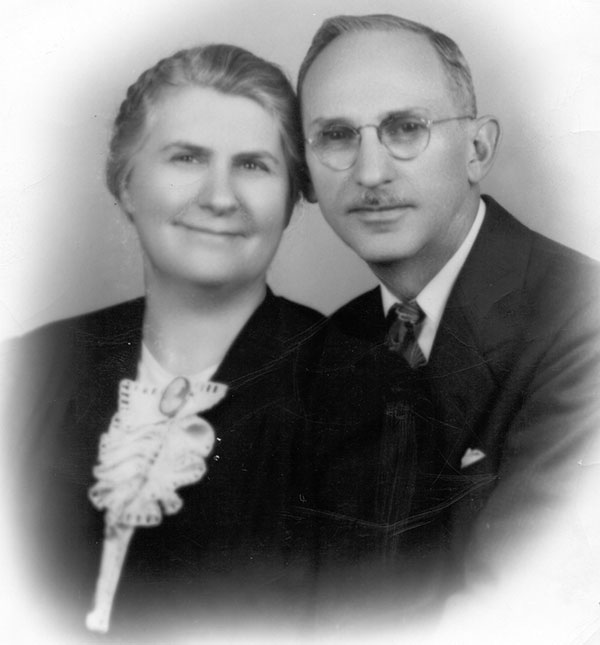
J. Roswell and Alice Reynolds Flower, circa 1935.
It is appropriate that the namesake of the Flower Pentecostal Heritage Center cared deeply about Pentecostal history. J. Roswell Flower wrote a widely-distributed booklet about the Fellowship’s history, he taught the standard Assemblies of God History and Polity course at Central Bible Institute, and he planned to write a denominational history book that he was unable to complete before his death. He also lived much of the history.[19]
Even at a young age, Flower recognized that history has spiritual value. He was 25 years old when he published the following brief admonition in the Christian Evangel (the predecessor of the Pentecostal Evangel): “Every Christian should study Church history alongside of his Bible. If we knew more Church history we would go astray less in our interpretation of the Word of God.”[20]
This observation by a revered Assemblies of God pioneer remains true today. It is easy to be swamped by prevailing popular worldviews, which can color one’s interpretation of Scripture. Knowledge of church history—learning from the wisdom of those who lived in other times and places—can liberate Christians from fashions and winds of doctrine, and it can also inspire Christians toward great things.
Assemblies of God leaders recognized the spiritual value of history when they established the Flower Pentecostal Heritage Center in 1977. They understood that the Pentecostal movement would have a limited future if the Pentecostal testimony is not transmitted to the next generation.
Forty years later, the Flower Pentecostal Heritage Center has become the largest archival repository of Pentecostal historical materials in the world. Church leaders, scholars, and people in the pew have entrusted their Pentecostal treasures to the Center’s dedicated archivists, who make these materials accessible to researchers online, by mail, and in person. Hopefully, these Pentecostal voices from across the chronological, linguistic, national, and denominational divides will inspire new generations to embrace the Pentecostal testimony as their own.
About the Authors
Wayne E. Warner served as director of the Flower Pentecostal Heritage Center from 1980 to 2005. He is retired and lives in Springfield with his wife, Pat.
Darrin J. Rodgers has served as director of the Flower Pentecostal Heritage Center since 2005. He lives in Springfield with his wife, Desiree.
Endnotes
- Menzies’ dissertation was titled, “The Assemblies of God, 1941-1967: The Consolidation of a Revival Movement” (Ph.D. diss., University of Iowa, 1968).
- William W. Menzies, Anointed to Serve: The Story of the Assemblies of God (Gospel Publishing House, 1971).
- Ibid, 11.
- Ibid.
- Board of Administration Minutes, March 6, 1974, 4; Glenn Gohr, “A Silver Anniversary for the Flower Pentecostal Heritage Center,” Assemblies of God Heritage 22:3 (Fall 2002): 4-9; Lee Shultz, telephone interview by Wayne Warner, August 27, 2002.
- Archives Study Committee’s report to the Board of Administration, March 1, 1974.
- Archives Study Committee’s report to the Board of Administration, February 11, 1975.
- Executive Presbytery Minutes, June 12, 1975, 23.
- “AGGS Houses Archives in New Facilities,” Pentecostal Evangel, February 12, 1978, 30.
- Ibid. AGGS was renamed Assemblies of God Theological Seminary in 1984.
- Ibid.
- Archives Study Committee minutes, May 9, 1978; Archives Advisory Committee minutes, March 20, 1979.
- According to Dollar Times the buying power of that $35,000 in 1978 is now worth $138,942.67 in 2018.
- The In Memoriam booklet began publication in 1959 as a four-page list of the names of deceased ministers from the previous biennium.
- Darrin J. Rodgers, Northern Harvest: Pentecostalism in North Dakota (Bismarck, ND: North Dakota District Council, 2003).
- “Personal Papers of Bishop J. O. Patterson, Sr. Deposited at FPHC,” Assemblies of God Heritage 31 (2011): 73.
- Ibid.
- Darrin J. Rodgers, “Global, Diverse, and Growing,” Assemblies of God Heritage 34 (2014): 2-3.
- David Ringer, J. Roswell Flower: A Brief Biography (Eugene, OR: Wipf and Stock, 2016). Flower’s booklet, The Origin and Development of the Assemblies of God, went through six editions from 1938 to 1954. His research and class notes were deposited at the FPHC.
- Christian Evangel, October 18, 1913, 8.
Do you have Pentecostal historical materials that should be preserved? Please consider depositing these materials at the Flower Pentecostal Heritage Center (FPHC). The FPHC, located in the Assemblies of God national offices, is the largest Pentecostal archives in the world. We would like to preserve and make your treasures accessible to those who write the history books. To learn more, click here.
